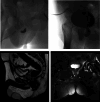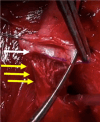Posterior urethroplasty for pelvic fracture urethral injuries: risk factors for recurrence and complications
- PMID: 40748395
- PMCID: PMC12316716
- DOI: 10.1007/s00345-025-05839-3
Posterior urethroplasty for pelvic fracture urethral injuries: risk factors for recurrence and complications
Abstract
Purpose: Surgical reconstruction for posterior urethral injuries associated with pelvic fractures (PFUI) is complex. Perineal posterior urethroplasty via excision and primary anastomosis (EPA) is the standard treatment. This study evaluates risk factors for stenosis recurrence after primary EPA and analyzes predictors of postoperative complications.
Methods: A retrospective analysis was conducted on male patients who underwent primary posterior EPA for PFUI at Ghent University Hospital (2001-2024). The primary outcome was stenosis recurrence at 1-, 2-, and 10-year follow-up, defined as urethral narrowing causing obstructive symptoms and requiring intervention. Demographic data, prior urethral manipulation, surgical techniques, 90-day complications (Clavien-Dindo), and functional outcomes were analyzed. Univariate and multivariate coxregression analyses were performed using IBM SPSS Statistics v. 29.0.2.0.
Results: Among 70 patients, 75.5% underwent transecting EPA. After a median follow-up of 130 months (IQR 78.5-178.5), stenosis recurrence occurred in 15.8% at a median of 3 months (IQR 2.0-5.0). The 1-, 2-, and 10-year recurrence-free survival rates were 85.4%, 83.8%, and 83.8%, respectively. In multivariate analysis, postoperative complications (HR = 4.85, p = 0.007) and persistent extravasation (HR = 6.36, p = 0.006) significantly increased recurrence risk. Postoperative complications (21.4%) were all low-grade and managed conservatively. Erectile function was impaired in 97.9% due to trauma, with 12.2% improving postoperatively. De novo urinary incontinence occurred in 6.6%.
Conclusions: Posterior urethroplasty demonstrates a high long-term success rate in patients with PFUI. Postoperative complications and persistent urinary leakage significantly increase the risk of surgical failure, highlighting the need for rigorous follow-up. The non-transecting technique, when possible, does not negatively impact outcomes.
Keywords: Pelvic fracture urethral injury; Posterior urethroplasty; Stenosis recurrence; Urethral reconstruction; Urethroplasty complications.
© 2025. The Author(s).
Conflict of interest statement
Declarations. Conflict of interest: The authors declare no competing interests. Ethical approval: The study was conducted in accordance with the Declaration of Helsinki and approved by the Institutional Review Board of of UZ Ghent, Ghent University Hospital, (Protocol Number EC/UZG/2008/234). Informed consent: Informed consent was obtained from all subjects involved in the study. Written informed consent has been obtained from the patient(s) to publish this paper.
Figures




Similar articles
-
Comparison of open perineal and robot-assisted reconstruction in vesicourethral anastomotic stenosis.World J Urol. 2025 Jul 7;43(1):413. doi: 10.1007/s00345-025-05808-w. World J Urol. 2025. PMID: 40622400
-
Non-Transecting Anastomotic Urethroplasty Versus Excision and Primary Anastomosis for Non-Traumatic Posterior Urethral Stenosis: A Preliminary Feasibility Study.Int J Urol. 2025 Aug;32(8):953-960. doi: 10.1111/iju.70073. Epub 2025 Apr 15. Int J Urol. 2025. PMID: 40231484
-
Vessel-sparing Non-transecting Anastomotic Reconstruction of the Posterior Urethra: Single Center Experience with Long-term Follow-up.Urology. 2025 Feb;196:283-289. doi: 10.1016/j.urology.2024.10.059. Epub 2024 Nov 8. Urology. 2025. PMID: 39522829
-
Primary realignment vs suprapubic cystostomy for the management of pelvic fracture-associated urethral injuries: a systematic review and meta-analysis.Urology. 2014 Apr;83(4):924-9. doi: 10.1016/j.urology.2013.12.031. Urology. 2014. PMID: 24680459
-
[Non-transecting anastomotic urethroplasty for strictures of the bulbar urethra. Systematic review].Urologiia. 2024 Mar;(1):135-142. Urologiia. 2024. PMID: 38650419 Russian.
References
-
- Johnsen NV, Kaufman MR, Dmochowski RR, Milam DF (2018) Erectile dysfunction following pelvic fracture urethral injury. Sex Med Rev 6:114–123 - PubMed
-
- Clark SS, Prudencio RF (1972) Lower urinary tract injuries associated with pelvic fractures: diagnosis and management. Surg Clin North Am 52:183–201 - PubMed
-
- Shenfeld OZ, Kiselgorf D, Gofrit ON, Verstandig AG, Landau EH, Pode D (2003) The incidence and causes of erectile dysfunction after pelvic fractures associated with posterior urethral disruption. J Urol 169:2173–2176 - PubMed
MeSH terms
LinkOut - more resources
Full Text Sources
Medical
Research Materials

